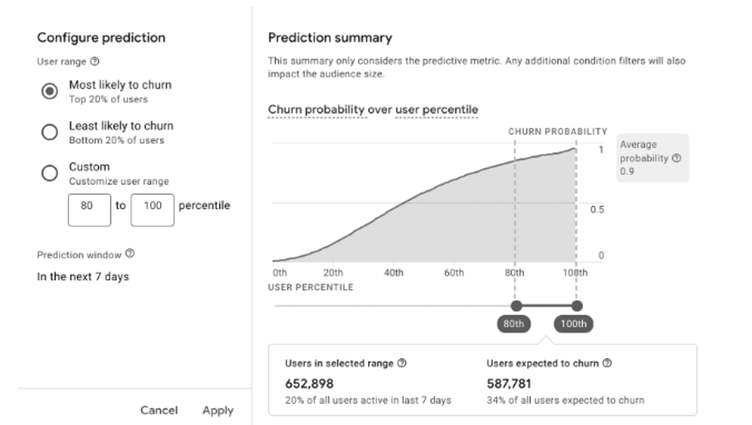
Google Analytics 4 (GA4) is transforming how businesses track and understand user behaviour. With a more flexible event-based data model and advanced features, GA4 is the tool you need to gain deeper insights into your website or app's performance. As we move through 2025, it’s crucial to stay ahead by mastering these features.
In this post, we’ll walk you through some of the most important ways you can use GA4 to improve your analytics and drive business growth.
Use predictive metrics to optimise campaigns
GA4 uses machine learning to predict user behaviour, such as purchase likelihood or the probability of a user returning to your site. The data comes from multiple channels: first-party data, real-time data, historical data, and contextual data. These sources can provide a more comprehensive view of customer behaviour and help you make more accurate predictions. These predictive metrics help you identify high-value customers before they even convert.
For instance, you can target users who are more likely to complete a purchase with personalised marketing campaigns or focus on re-engaging users at risk of abandoning their shopping cart. Leveraging this data, combined with GA4’s predictive capabilities, helps businesses optimise their marketing campaigns in real time, target high-value customers, and improve conversion rates.
Example of predictive churn metrics in GA4
The image below shows how GA4 predicts churn probabilities based on user activity. By customising user ranges, businesses can forecast the likelihood of a user churning, allowing for more targeted marketing efforts.

This visualisation can help businesses understand which segments of their audience are at the highest risk and take proactive steps to improve retention.
Refine attribution models to match your strategy
Attribution in GA4 allows you to assess the effectiveness of different marketing channels in driving conversions. You can customise attribution models to fit your business objectives, whether it's tracking first-touch, last-touch, or linear attribution.
Custom attribution models help you understand which marketing efforts provide the best return on investment. For example, if you’re running a mix of ads, email campaigns, and organic content, GA4’s attribution models can reveal which channels are most impactful.
To learn more about how to implement revenue attribution modelling in GA4, check out the step-by-step guide to simplifying this process.
Cookieless tracking capabilities in GA4
As digital marketing evolves, privacy concerns have become paramount, leading to the decline of third-party cookies. GA4 addresses this shift by offering robust cookieless measurement solutions that uphold user privacy while delivering accurate analytics.
Privacy-first tracking
GA4 supports cookieless measurement through tools aligned with the Chrome Privacy Sandbox, ensuring precise tracking without relying on third-party cookies. This approach helps businesses remain compliant with evolving privacy regulations.
Enhanced use of first-party data
GA4 enhances businesses' ability to utilise their data through features like Customer Match. This tool allows businesses to safely use their customers' information for audience targeting in Google Ads. By adopting GA4's cookieless measurement capabilities, businesses can navigate the changing digital landscape, ensuring that user privacy is respected without compromising the quality of analytics. This balance helps maintain user trust while achieving marketing objectives.
Pro Tip: BigQuery integration
For advanced users, GA4 offers BigQuery integration, which is now available to all users, not just those on paid plans. This means you can export raw data from GA4 directly into BigQuery for deeper, custom analysis. If you’re familiar with SQL, this integration can be especially valuable. While BigQuery requires a bit of learning compared to GA4's standard features, it provides more flexibility and control over your data, enabling you to perform in-depth analysis beyond the built-in reports.
Mastering GA4’s advanced features may feel overwhelming, especially for businesses already juggling multiple priorities. But now is an excellent time to take advantage of these powerful tools. By leveraging GA4’s predictive metrics, refined attribution models, cookieless measurement capabilities, and BigQuery integration, businesses can stay competitive, optimise their marketing strategies, and enhance customer engagement.
Adopting GA4’s capabilities doesn’t just provide a competitive edge. It ensures you're equipped to make informed, data-driven decisions that lead to long-term growth. The future of analytics is here, and the sooner you start utilising GA4 to its full potential, the better your business will be positioned for success in 2025.
Copyright 2025. Guest post.